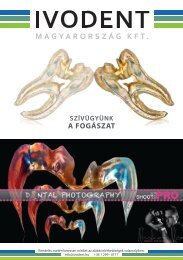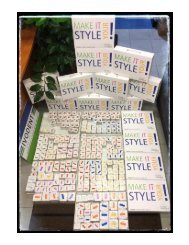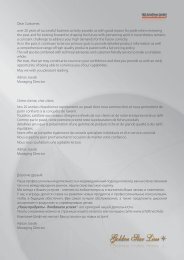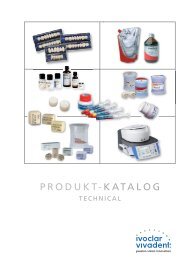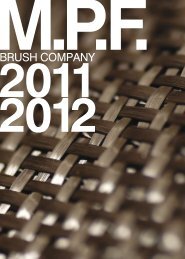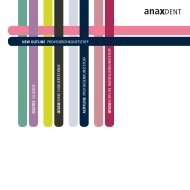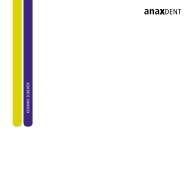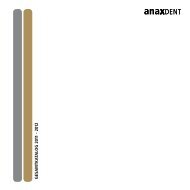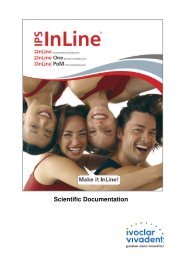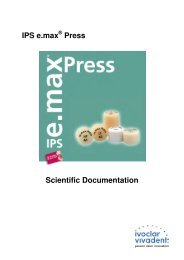IPS e.max ZirPress Scientific Documentation
You also want an ePaper? Increase the reach of your titles
YUMPU automatically turns print PDFs into web optimized ePapers that Google loves.
<strong>IPS</strong> e.<strong>max</strong> ® <strong>ZirPress</strong><br />
<strong>Scientific</strong> <strong>Documentation</strong>
<strong>Scientific</strong> <strong>Documentation</strong> <strong>IPS</strong> e.<strong>max</strong> ® <strong>ZirPress</strong> Page 2 of 16<br />
Table of contents<br />
1. Introduction .................................................................................................................. 3<br />
1.1 Overview of <strong>IPS</strong> e.<strong>max</strong> range of products ........................................................................ 3<br />
1.2 <strong>IPS</strong> e.<strong>max</strong> <strong>ZirPress</strong> .............................................................................................................. 4<br />
2. Technical data .............................................................................................................. 6<br />
3. Material science investigations................................................................................... 7<br />
3.1 Physical properties ............................................................................................................. 7<br />
3.2 Compatibility with <strong>IPS</strong> e.<strong>max</strong> materials............................................................................. 7<br />
3.3 Press and firing temperatures (comparison).................................................................. 10<br />
4. In vitro examinations ..................................................................................................11<br />
4.1 Fracture strength of inlay-retained bridges.................................................................... 11<br />
4.2 Compatibility of <strong>IPS</strong> e.<strong>max</strong> <strong>ZirPress</strong> with zirconium oxide frameworks...................... 11<br />
5. External clinical studies..............................................................................................13<br />
5.1 University of Heidelberg, Germany ................................................................................. 13<br />
5.2 University of Aachen, Germany ....................................................................................... 13<br />
5.3 University of Michigan, U.S.A. ......................................................................................... 13<br />
5.4 Conclusions ....................................................................................................................... 14<br />
6. Biocompatibility ..........................................................................................................14<br />
6.1 Introduction........................................................................................................................ 14<br />
6.2 Chemical durability ........................................................................................................... 14<br />
6.3 In vitro cytotoxicity............................................................................................................ 14<br />
6.4 Sensitization, irritation...................................................................................................... 15<br />
6.5 Radioactivity ...................................................................................................................... 15<br />
6.6 Conclusions ....................................................................................................................... 15<br />
7. Literature .....................................................................................................................16
<strong>Scientific</strong> <strong>Documentation</strong> <strong>IPS</strong> e.<strong>max</strong> ® <strong>ZirPress</strong> Page 3 of 16<br />
1. Introduction<br />
1.1 Overview of <strong>IPS</strong> e.<strong>max</strong> range of products<br />
<strong>IPS</strong> e.<strong>max</strong> is an all-ceramic system that consists of the following five components:<br />
• <strong>IPS</strong> e.<strong>max</strong> Press (lithium disilicate glass-ceramic ingot for the press technique)<br />
• <strong>IPS</strong> e.<strong>max</strong> <strong>ZirPress</strong> (fluorapatite glass-ceramic ingot for the press-on technique)<br />
• <strong>IPS</strong> e.<strong>max</strong> CAD (lithium disilicate glass-ceramic block for the CAD/CAM technique)<br />
• <strong>IPS</strong> e.<strong>max</strong> ZirCAD (zirconium oxide block for the CAD/CAM technique)<br />
• <strong>IPS</strong> e.<strong>max</strong> Ceram (fluorapatite veneering ceramic)
<strong>Scientific</strong> <strong>Documentation</strong> <strong>IPS</strong> e.<strong>max</strong> ® <strong>ZirPress</strong> Page 4 of 16<br />
1.2 <strong>IPS</strong> e.<strong>max</strong> <strong>ZirPress</strong><br />
Fig. 1: <strong>IPS</strong> e.<strong>max</strong> <strong>ZirPress</strong><br />
<strong>IPS</strong> e.<strong>max</strong> <strong>ZirPress</strong> (Fig. 1) assumes the function and<br />
properties of the currently conventionally layered and<br />
sintered Margin and Dentin materials. <strong>IPS</strong> e.<strong>max</strong> <strong>ZirPress</strong><br />
is used to press the dentin layer onto the zirconium oxide<br />
frameworks. The stable pressable ceramic enables cuspsupporting<br />
frameworks, so that the layering ceramic can<br />
be applied in an even thickness. Due to the ingot delivery<br />
form, an improved homogeneity (porosity and bond) of the<br />
marginal and dentin areas is achieved. <strong>IPS</strong> e.<strong>max</strong> <strong>ZirPress</strong><br />
can be veneered using <strong>IPS</strong> e.<strong>max</strong> Ceram or fully<br />
anatomically pressed, stained and glazed.<br />
1.2.1 Material<br />
<strong>IPS</strong> e.<strong>max</strong> <strong>ZirPress</strong> contains glass-ceramic and fluorapatite crystals Ca 5 (PO 4 ) 3 F. It does not<br />
contain any feldspar or leucite. The fluorapatite crystals incorporated into the ceramic vary in<br />
size (Fig. 2). The crystals can be grown to the desired dimension by means of controlled<br />
nucleation and crystallization. The nano-scale fluorapatite crystals are less than 300 nm in<br />
length and approx. 100 nm in diameter (Fig. 3). In addition, fluorapatite crystals that have<br />
been grown along the longitudinal axis are also present; they measure 2-5 µm in length and<br />
less than 300 nm in diameter. Depending on the orientation of the crystals in the ground<br />
section of the specimen, the cross-sections appear either square or circular.<br />
The nano-scale fluorapatite crystals are responsible for the material’s opalescence and<br />
thereby decisively contribute to its aesthetic properties. The material’s opacity (level of<br />
transparency) is mainly determined by the larger fluorapatite crystals.<br />
Due to the light scattering effect produced by the differently sized fluorapatite crystals, optical<br />
effects, such as opalescence, brightness, opacity and translucency can be adjusted in a<br />
targeted fashion with <strong>IPS</strong> e.<strong>max</strong> <strong>ZirPress</strong>.
<strong>Scientific</strong> <strong>Documentation</strong> <strong>IPS</strong> e.<strong>max</strong> ® <strong>ZirPress</strong> Page 5 of 16<br />
Fig. 2: <strong>IPS</strong> e.<strong>max</strong> <strong>ZirPress</strong>: fluorapatite crystals in<br />
different sizes (fracture surface; etched with 3%<br />
HF for 10 s)<br />
Fig. 3: <strong>IPS</strong> e.<strong>max</strong> <strong>ZirPress</strong> with fluorapatite<br />
crystals in the nanometer range (etched with 3%<br />
HF for 10 s)
<strong>Scientific</strong> <strong>Documentation</strong> <strong>IPS</strong> e.<strong>max</strong> ® <strong>ZirPress</strong> Page 6 of 16<br />
2. Technical data<br />
<strong>IPS</strong> e.<strong>max</strong> <strong>ZirPress</strong><br />
Pressed ceramic ingot<br />
Standard composition: (in wt %)<br />
SiO 2 57.0 – 62.0<br />
Al 2 O 3 12.0 – 16.0<br />
Na 2 O 7.0 – 10.0<br />
K 2 O 6.0 – 8.0<br />
CaO 2.0 – 4.0<br />
ZrO 2 1.5 – 2.5<br />
P 2 O 5 1.0 – 2.0<br />
F 0.5 – 1.0<br />
+ other oxides 0.0 – 6.0<br />
+ Pigments 0.2 – 0.9<br />
Physical properties:<br />
In accordance with:<br />
ISO 6872 Dental ceramic<br />
ISO 9693 Metal-ceramic dental restorative systems<br />
Type II ceramic<br />
Flexural strength (biaxial)<br />
110 ± 10 MPa<br />
Chemical solubility 30 ± 10 µg/cm 2<br />
Coefficient of thermal expansion (100 – 400 °C) 9.75 ± 0.25 10 -6 /K<br />
Coefficient of thermal expansion (100 – 500 °C) 9.85 ± 0.25 10 -6 /K<br />
Glass transition temperature (Tg) 530 ± 10 °C
<strong>Scientific</strong> <strong>Documentation</strong> <strong>IPS</strong> e.<strong>max</strong> ® <strong>ZirPress</strong> Page 7 of 16<br />
3. Materials science investigations<br />
3.1 Physical properties<br />
Tab 1: Physical properties<br />
Feature<br />
Value / Note<br />
Vickers hardness<br />
5400 ± 200 MPa<br />
Biaxial strength (ISO 6872) see Technical data (Chapter 2)<br />
Glass transition temperature (Tg) see Technical data (Chapter 2)<br />
CTE (100 – 400 °C) see Technical data (Chapter 2)<br />
3.2 Compatibility with <strong>IPS</strong> e.<strong>max</strong> materials<br />
3.2.1 Coefficient of thermal expansion<br />
The linear thermal expansion of materials is measured with a dilatometer. The specimen is<br />
continuously heated/cooled and the linear dimensional change recorded. The resulting<br />
change in length may occur in a steady or discontinuous curve. A jump in the curve can be<br />
seen if a phase transition occurs in the material. The linear coefficient of thermal expansion<br />
(CTE) is determined per unit length for 1 degree change in temperature (1 Kelvin). The CTE<br />
largely depends on the temperature range within which it is measured. Therefore, the<br />
temperature range has to be stated at all times, as the CTE alone does not have much<br />
informative value. The CTE of dental ceramics is determined within a temperature range that<br />
includes temperatures below the glass transition point (Tg) . The CTE is used to identify<br />
potential stress levels that the ceramic may have to endure in conjunction with the framework<br />
and/or layering material. Glass-ceramics at temperatures above the Tg value are soft and the<br />
stress is dissipated by the flow of the material.<br />
The CTE is expressed in [10 -6·K -1 ] according to ISO 9693. However, [1µm/m·K] is also<br />
commonly used.<br />
The coefficient of thermal expansion provides a clue as to whether the layering material is<br />
compatible with the framework material.<br />
Ceramic materials are very susceptible to tensile stress. As a consequence, the coefficient of<br />
thermal expansion (CTE) of the layering material should be lower than that of the more rigid<br />
framework material.<br />
In addition, the coefficients of thermal expansion (CTE) of the materials in use have to be<br />
coordinated (Fig. 4).
<strong>Scientific</strong> <strong>Documentation</strong> <strong>IPS</strong> e.<strong>max</strong> ® <strong>ZirPress</strong> Page 8 of 16<br />
11.5<br />
11<br />
10.5<br />
CTE (100°-400°C)<br />
10<br />
9.5<br />
9<br />
8.5<br />
8<br />
<strong>IPS</strong> e.<strong>max</strong><br />
Ceram<br />
<strong>IPS</strong> e.<strong>max</strong><br />
<strong>ZirPress</strong><br />
<strong>IPS</strong> e.<strong>max</strong><br />
ZirCAD<br />
Fig. 4: CTE of the individual material layers in the <strong>IPS</strong> e.<strong>max</strong> system<br />
The CTE of <strong>IPS</strong> e.<strong>max</strong> <strong>ZirPress</strong> is one unit lower than that of the <strong>IPS</strong> e.<strong>max</strong> ZirCAD<br />
framework material placed underneath.
<strong>Scientific</strong> <strong>Documentation</strong> <strong>IPS</strong> e.<strong>max</strong> ® <strong>ZirPress</strong> Page 9 of 16<br />
3.2.2 Bond<br />
The bond between <strong>IPS</strong> e.<strong>max</strong> <strong>ZirPress</strong> and other materials can be clearly seen in the SEM<br />
images below. The “compo contrast” image has been produced with a special imaging<br />
technique: In line with signals transmitted from the backscattering electrons (BSE), the<br />
different materials of the samples are depicted in various degrees of brightness.<br />
The bond of <strong>IPS</strong> e.<strong>max</strong> <strong>ZirPress</strong> to the <strong>IPS</strong><br />
e.<strong>max</strong> ZirCAD (Liner) framework and the<br />
<strong>IPS</strong> e.<strong>max</strong> Ceram layering material is<br />
homogeneous, non-porous and crack-free<br />
(Figs. 5 to 7).<br />
Fig. 5: Bond of <strong>IPS</strong> e.<strong>max</strong> ZirCAD – ZirLiner – <strong>IPS</strong><br />
e.<strong>max</strong> <strong>ZirPress</strong> (compo contrast)<br />
Fig. 6: Bond of <strong>IPS</strong> e.<strong>max</strong> ZirCAD to the ZirLiner<br />
(compo contrast)<br />
Fig. 7: Transition between <strong>IPS</strong> e.<strong>max</strong> Ceram<br />
(top left) and <strong>IPS</strong> e.<strong>max</strong> <strong>ZirPress</strong> (bottom right)
<strong>Scientific</strong> <strong>Documentation</strong> <strong>IPS</strong> e.<strong>max</strong> ® <strong>ZirPress</strong> Page 10 of 16<br />
3.3 Press and firing temperatures (comparison)<br />
The difference between the press temperature of the pressed ceramic and the firing<br />
temperature of the veneering ceramic should be as big as possible. This will increase the<br />
stability of the pressed component while the veneer is fired. The accuracy of fit of the<br />
restoration is thus improved.<br />
Press or<br />
firing temperature [°C]<br />
1200<br />
1000<br />
800<br />
600<br />
400<br />
200<br />
0<br />
<strong>IPS</strong> e.<strong>max</strong> <strong>ZirPress</strong> CZR Press Cercon Press<br />
400<br />
350<br />
300<br />
250<br />
200<br />
150<br />
100<br />
50<br />
0<br />
Temperature difference [°C]<br />
Press temperature<br />
Firing temperature<br />
layering<br />
Temperature difference<br />
Fig. 8: Press and firing temperatures, as well as temperature differences between pressed and<br />
veneering ceramics (Ivoclar Vivadent AG, 2004/2005)<br />
Among the materials tested, the <strong>IPS</strong> e.<strong>max</strong> system with the <strong>IPS</strong> e.<strong>max</strong> <strong>ZirPress</strong> and<br />
<strong>IPS</strong> e.<strong>max</strong> Ceram components shows the largest difference between the press and<br />
firing temperature.
<strong>Scientific</strong> <strong>Documentation</strong> <strong>IPS</strong> e.<strong>max</strong> ® <strong>ZirPress</strong> Page 11 of 16<br />
4. In vitro examinations<br />
4.1 Fracture strength of inlay-retained bridges<br />
Gabbert et al. 1 determined the fracture strength of metal-free inlay-retained bridges. The<br />
influence of two different gap widths were examined (molar, as well as premolar and molar).<br />
Zirconium oxide frameworks were fabricated by means of the CAD/CAM technique and<br />
pressed over with <strong>IPS</strong> e.<strong>max</strong> <strong>ZirPress</strong>. Subsequently, industrially prefabricated zirconium<br />
oxide pontics (diameter of 2x2 mm) were veneered with Artglass, a glass-fibre-reinforced<br />
composite. These zirconium oxide pontics were placed in two different areas of the inlay<br />
preparation: in the occlusal area or in the proximal box. Eight samples were fabricated per<br />
test series. The bridges were adhesively cemented (Variolink II). After 60,000 chewing cycles<br />
at 50 N and 10,000 thermocycles of 6.5 °C / 60 °C, the bridges were loaded to the point of<br />
fracture.<br />
1600<br />
1400<br />
Fracture resistance [N]<br />
1200<br />
1000<br />
800<br />
600<br />
400<br />
200<br />
0<br />
molar<br />
occlusal proximal all-ceramic<br />
premolar + molar<br />
Fig. 9: Fracture resistance of metal-free inlay-retained bridges with zirconium oxide frameworks<br />
(Gabbert et al., 2004) 1<br />
The position of the pontic and the gap width had no significant influence on the<br />
fracture load.<br />
Bridges veneered with <strong>IPS</strong> e.<strong>max</strong> <strong>ZirPress</strong> showed significantly higher strength<br />
values than pontics veneered with Artglass.<br />
4.2 Compatibility of <strong>IPS</strong> e.<strong>max</strong> <strong>ZirPress</strong> with zirconium oxide frameworks<br />
The incidence of chipping is an important clinical benchmark to estimate the survival rate, or<br />
the potential need for repair, of a dental reconstruction.<br />
For the purpose of testing the pressed-on crowns in the Willytec chewing simulator, the<br />
crowns were placed on standardized dies and subjected to eccentric loading with a steel<br />
antagonist. The antagonist performed a translational motion (depth of stroke = 2.0 mm,
<strong>Scientific</strong> <strong>Documentation</strong> <strong>IPS</strong> e.<strong>max</strong> ® <strong>ZirPress</strong> Page 12 of 16<br />
length of stroke = 5 mm, travel speed = 40 mm/s) from the fossa up to 1 mm below the tip of<br />
the distobuccal cusp at loads from 3 and 5 to 9 kg. Each loading phase consisted of 100,000<br />
loading cycles and 300 cycles of thermocycling (5 °C/55 °C).<br />
A variety of zirconium oxide materials were pressed over with <strong>IPS</strong> e.<strong>max</strong> <strong>ZirPress</strong> and tested<br />
in the in-house laboratory.<br />
100<br />
80<br />
Survival rate [%]<br />
60<br />
40<br />
20<br />
0<br />
Everest<br />
BIO ZS<br />
(N=8)<br />
Procera<br />
(N=4)<br />
LAVA<br />
(opaque)<br />
(N=8)<br />
LAVA<br />
(A3)<br />
(N=8)<br />
Digident<br />
(N=4)<br />
Diatomic<br />
(uncolored)<br />
(N=4)<br />
Diatomic<br />
(colored)<br />
(N=4)<br />
Fig. 10: Proportion of crowns (<strong>IPS</strong> e.<strong>max</strong> <strong>ZirPress</strong>/zirconium oxide) which survived the artificial<br />
chewing in the chewing simulator without chipping (Ivoclar Vivadent AG, Schaan, 2005)<br />
<strong>IPS</strong> e.<strong>max</strong> <strong>ZirPress</strong> produced hardly any chipping (if any at all) in conjunction with<br />
various zirconium oxide frameworks.
<strong>Scientific</strong> <strong>Documentation</strong> <strong>IPS</strong> e.<strong>max</strong> ® <strong>ZirPress</strong> Page 13 of 16<br />
5. External clinical studies<br />
5.1 University of Heidelberg<br />
Head of study:<br />
Title:<br />
Objective:<br />
Experimental:<br />
Results:<br />
Prof. Rammelsberg, University, Heidelberg<br />
Clinical study on all-ceramic, zirconium oxide-based inlay-retained<br />
bridges manufactured using a CAD/CAM technique<br />
To examine the clinical performance of <strong>IPS</strong> e.<strong>max</strong> <strong>ZirPress</strong> pressed on<br />
inlay-retained bridges made of zirconium oxide<br />
Thirty inlay-retained bridges were incorporated; each bridge included at<br />
least one inlay as bridge anchor. The frameworks were made of<br />
zirconium oxide onto which <strong>IPS</strong> e.<strong>max</strong> <strong>ZirPress</strong> was pressed. The<br />
resultant restorations were veneered with <strong>IPS</strong> e.<strong>max</strong> Ceram.<br />
Neither framework fractures nor chipping of the veneering material has<br />
been reported to date.<br />
5.2 University of Aachen<br />
Head of study:<br />
Title:<br />
Objective:<br />
Experimental:<br />
Results:<br />
Dr. Tinschert, University, Aachen<br />
Prospective clinical study on the survival rate of posterior zirconium<br />
oxide-reinforced crowns manufactured using the press-on technique<br />
To examine the clinical performance of <strong>IPS</strong> e.<strong>max</strong> <strong>ZirPress</strong> pressed on<br />
crowns made of zirconium oxide<br />
Thirty posterior crowns comprising zirconium oxide copings made of<br />
DC Zirkon, Lava and <strong>IPS</strong> e.<strong>max</strong> ZirCAD were incorporated. <strong>IPS</strong> e.<strong>max</strong><br />
<strong>ZirPress</strong> was pressed onto the copings. Subsequently, the copings<br />
were veneered with <strong>IPS</strong> e.<strong>max</strong> Ceram.<br />
Neither framework fractures nor chipping of the veneering material has<br />
been reported to date.<br />
5.3 University of Michigan<br />
Head of study:<br />
Title:<br />
Objective:<br />
Experimental:<br />
Results:<br />
Prof. Fasbinder, University of Michigan, Ann Arbor<br />
Clinical performance of <strong>IPS</strong> e.<strong>max</strong> Ceram on <strong>IPS</strong> e.<strong>max</strong> <strong>ZirPress</strong> and<br />
<strong>IPS</strong> e.<strong>max</strong> ZirCAD<br />
To examine the clinical performance of <strong>IPS</strong> e.<strong>max</strong> <strong>ZirPress</strong> pressed on<br />
restorations made of <strong>IPS</strong> e.<strong>max</strong> ZirCAD<br />
Thirty crowns and 10 bridges made of <strong>IPS</strong> e.<strong>max</strong> ZirCAD/<strong>IPS</strong> e.<strong>max</strong><br />
<strong>ZirPress</strong>/<strong>IPS</strong> e.<strong>max</strong> Ceram were placed.<br />
Neither framework fractures nor chipping of the veneering material was<br />
observed after all restorations had been incorporated.
<strong>Scientific</strong> <strong>Documentation</strong> <strong>IPS</strong> e.<strong>max</strong> ® <strong>ZirPress</strong> Page 14 of 16<br />
5.4 Conclusions<br />
The clinical data to date show that the press-on technique in conjunction with zirconium<br />
oxide frameworks in general and <strong>IPS</strong> e.<strong>max</strong> ZirCAD with <strong>IPS</strong> e.<strong>max</strong> <strong>ZirPress</strong> in particular<br />
results in successful and aesthetic restorations. For this purpose, the parameters specified in<br />
the Instructions for Use have to be observed.<br />
6. Biocompatibility<br />
6.1 Introduction<br />
All-ceramic materials are known for their high levels of biocompatibility 2,3<br />
The main ingredients of <strong>IPS</strong> e.<strong>max</strong> <strong>ZirPress</strong> (SiO 2 , K 2 O, ZnO, ZrO 2 , Li 2 O, CaO, Na 2 O, Al 2 O 3 )<br />
are the same as those of the <strong>IPS</strong> Eris for E2 and <strong>IPS</strong> Empress 2 ceramic layering materials,<br />
which have been successfully used in clinical applications for many years. Hence, it can be<br />
assumed that <strong>IPS</strong> e.<strong>max</strong> <strong>ZirPress</strong> offers the same high levels of biocompatibility as these<br />
materials.<br />
6.2 Chemical durability<br />
Dental materials are exposed to a wide range of pH-values and temperatures in the oral<br />
environment. Therefore, chemical durability is an important prerequisite for dental materials.<br />
According to Anusavice 4 ceramic materials are among the most durable dental materials.<br />
The in-house laboratory determined the chemical durability of <strong>IPS</strong> e.<strong>max</strong> <strong>ZirPress</strong> according<br />
to the relevant test described in ISO 6872 as well as in a test using artificial saliva:<br />
Test<br />
Chemical solubility<br />
[µg/cm 2 ]:<br />
Limit value [µg/cm 2 ]:<br />
According to ISO 6872 30 ± 10 < 100<br />
In artificial saliva 30 ± 10 --<br />
(Ivoclar Vivadent AG, Schaan, 2005)<br />
The chemical solubility of <strong>IPS</strong> e.<strong>max</strong> <strong>ZirPress</strong> is far lower than the <strong>max</strong>imum level<br />
permitted by the relevant standard.<br />
6.3 In vitro cytotoxicity<br />
<strong>IPS</strong> e.<strong>max</strong> <strong>ZirPress</strong> comprises the same ingredients as the <strong>IPS</strong> Empress 2 and <strong>IPS</strong> Eris for<br />
E2 veneering materials. Hence, it can be concluded that <strong>IPS</strong> e.<strong>max</strong> <strong>ZirPress</strong> does not have<br />
any toxic potential.<br />
The in vitro toxicity of <strong>IPS</strong> Empress 2 and <strong>IPS</strong> Eris for E2 was determined in previous<br />
investigations:<br />
The in vitro toxicity was tested by NIOM, the Scandinavian Institute of Dental Materials,<br />
Haslum, Norway by means of a direct cell contact test.<br />
The test was conducted according to ISO 10993-5: Biological evaluation of medical devices<br />
Part 5: Tests for in vitro cytotoxicity.<br />
Under the given test conditions, no cytotoxic potential has been observed 5
<strong>Scientific</strong> <strong>Documentation</strong> <strong>IPS</strong> e.<strong>max</strong> ® <strong>ZirPress</strong> Page 15 of 16<br />
6.4 Sensitization, irritation<br />
Cavazos 6 , Henry et al. 7 and Allison et al. 8 demonstrated that dental ceramics – unlike other<br />
dental materials - do not induce a negative response when they come into contact with the<br />
oral mucous membrane. Mitchell 9 as well as Podshadley and Harrison 10 showed that glazed<br />
ceramics, which were used in implant-based trials, caused only very mild inflammatory<br />
reactions and had a far less irritating effect than other accepted dental materials, such as<br />
gold and composite resin.<br />
As it can be virtually ruled out that ceramic materials cause direct irritations in the cells of the<br />
mucous membrane, possible irritations may generally be attributed to mechanical irritation.<br />
Normally, such reactions can be prevented by observing the <strong>IPS</strong> e.<strong>max</strong> <strong>ZirPress</strong> Instructions<br />
for Use.<br />
Compared to other dental materials, ceramic has no or very little potential to cause<br />
irritation or sensitizing reactions.<br />
6.5 Radioactivity<br />
The radioactivity of <strong>IPS</strong> Eris for E2 and <strong>IPS</strong> Empress 2 was determined at the Research<br />
Centre Jülich. The values measured were
<strong>Scientific</strong> <strong>Documentation</strong> <strong>IPS</strong> e.<strong>max</strong> ® <strong>ZirPress</strong> Page 16 of 16<br />
7. Literature<br />
1 Gabbert O, Schmitter M, Gilde H, Rammelsberg P (2004). Frakturfestigkeit metallfreier<br />
Inlaybrücken mit Zirkonoxidgerüsten. Abstracts, 53. Jahrestagung der DGZPW Kiel<br />
2 Roulet JF, Herder S. Seitenzahnversorgung mit adhäsiv befestigten Keramikinlays. Quintessenz<br />
Verlags-GmbH, Berlin, 1985<br />
3 McLean JW. Wissenschaft und Kunst der Dentalkeramik. Verlag „Die Quintessenz“, Berlin, 1978<br />
4 Anusavice KJ. Degradability of Dental Ceramics. Adv Dent Res 6 (1992) 82-89<br />
5 NIOM Test Report (2003); No 004/04<br />
6 Cavazos E. Tissue response to fixed partial denture pontics. J Prosth Dent 20 (1968) 143<br />
7 Henry P et al. Tissue changes beneath fixed partial dentures. J Prosth Dent 16 (1966) 937<br />
8 Allison JR et al. Tissue changes under acrylic and porcelain pontics. J Dent Res 37 (1958) 66<br />
9 Mitchell DF. The irritational qualities of dental materials. JADA 59 (1959) 954<br />
10 Podshadley AG, Harrison JD. Rat connective tissue response to pontic material. J Prosth Dent 16<br />
(1966) 110<br />
11 Küppers G., Analysenbericht (2003): Bestimmung der gamma-Aktivitäten in<br />
Dentalkeramikproben, Forschungszentrum Jülich<br />
12 Petri H., Analysenbericht (1997): Bestimmung der Radioaktivität von 9 Keramikproben mittels<br />
gamma –Spektroskopie, Forschungszentrum Jülich<br />
This documentation contains a survey of internal and external scientific data (“Information”). The<br />
documentation and Information have been prepared exclusively for use in-house by Ivoclar Vivadent<br />
and for external Ivoclar Vivadent partners. They are not intended to be used for any other purpose.<br />
While we believe the Information is current, we have not reviewed all of the Information, and we<br />
cannot and do not guarantee its accuracy, truthfulness, or reliability. We will not be liable for use of or<br />
reliance on any of the Information, even if we have been advised to the contrary. In particular, use of<br />
the information is at your sole risk. It is provided "as-is", "as available" and without any warranty<br />
express or implied, including (without limitation) of merchantability or fitness for a particular purpose.<br />
The Information has been provided without cost to you and in no event will we or anyone associated<br />
with us be liable to you or any other person for any incidental, direct, indirect, consequential, special,<br />
or punitive damages (including, but not limited to, damages for lost data, loss of use, or any cost to<br />
procure substitute information) arising out of your or another’s use of or inability to use the Information<br />
even if we or our agents know of the possibility of such damages.<br />
Ivoclar Vivadent AG<br />
Research and Development<br />
<strong>Scientific</strong> Services<br />
Bendererstrasse 2<br />
FL – 9494 Schaan<br />
Liechtenstein<br />
Contents: Petra Bühler-Zemp / Dr. Thomas Völkel<br />
Edition: September 2005




